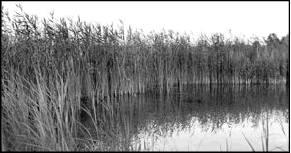Phragmites: Man’s Swiss army knife for millennia
Phragmites australis, the common reed, is a tall, perennial cane-type grass that forms colonies in wetlands. It is in the grass family, Poaceae, found in Texas and warm regions of the world. There are several species in the Phragmites genus and several cultivars and varieties of P. australis that are used in the same way. Phragmites spp. means one of several species. The genus name, Phragmites, means “growing in hedges.” The plant forms thick stands that separate land from water the way a hedge separates land. It provides phytoremediation by filtering water that moves through it. It builds land by trapping silt.
The common reed grows to 12 feet or more in dense stands along waterways. Leaves are alternate and can be 2 inches wide. It has a hard-hollow stem that is usually about ½ inch wide but can be wider. The stem has nodes, similar to bamboo. Flowers, panicles, are 6 to 20 inches and grow at the top of the stem. They may be white or beige, red or brown to black. At first, they grow straight up but later they lean to one side as if blown by the wind. The plant reproduces by seed, rhizome which is the root-like main stem and stolons which are horizontal runners.
It provides a wildlife habitat for land and aquatic animals such as amphibians, reptiles and ducks. Submerged parts of the plant support microorganisms that provide food for fish. For man, the roots, shoots, leaves and seeds are eaten raw or cooked. Sugar is extracted from the stalks.
Traditional medicine systems have used the common reed to treat lung, urinary tract infections, digestive problems, etc. Skin infections were treated with the leaf ash. Phragmites spp. is in the Food and Drug Administration Poisonous Plant Database at fda.gov.
I think of the common reed as a Swiss army knife of the plant world. It has been useful to man for millennia. Following are a few uses: Arrow shafts, basketry, brooms, cordage, dye, fences, fishing poles, framing, fringe on clothing, fuel, furniture, game pieces, insulation, jewelry, mats, musical instruments, paper, pens for writing, rafts, smoking utensils, splints for broken bones, storage containers, stuffing for upholstery, thatch, tools and traps. Studies are being done for its potential for bioenergy and the creation of new industrial materials.
But it spreads quickly and can cause problems. It may create land where it isn’t wanted, blocking the path of some fish. It can change the course of waterways causing problems for farmers and ranchers. Phragmites spp. is a noxious weed in many places including Texas.
The article “Ecosystem services of Phragmites in North America with emphasis on habitat functio ns” at the National Institutes of Health, ncbi.nlm.nih.gov, discusses the benefits of the plant and looks for ways to reduce the harm it causes.
The Native American Ethnobotany Database at naeb.brit.org says there is a Navajo legend that the first people came to Earth on a reed.
Deborah Richardson is a freelance reporter for The Examiner with a fondness for flora in its natural setting.


